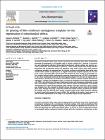| dc.contributor.author | Kelly, Daniel | |
| dc.date.accessioned | 2021-01-25T21:04:58Z | |
| dc.date.available | 2021-01-25T21:04:58Z | |
| dc.date.issued | 2020 | |
| dc.date.submitted | 2020 | en |
| dc.identifier.citation | Critchley S, Sheehy EJ, Cunniffe G, Diaz-Payno P, Carroll SF, Jeon O, Alsberg E, Brama PAJ, Kelly DJ. 3D printing of fibre-reinforced cartilaginous templates for the regeneration of osteochondral defects. Acta Biomaterialia, 2020 Sep 1;113:130-143 | en |
| dc.identifier.other | Y | |
| dc.identifier.uri | http://hdl.handle.net/2262/94805 | |
| dc.description.abstract | Successful osteochondral defect repair requires regenerating the subchondral bone whilst simultaneously promoting the development of an overlying layer of articular cartilage that is resistant to vascularization and endochondral ossification. During skeletal development articular cartilage also functions as a surface growth plate, which postnatally is replaced by a more spatially complex bone-cartilage interface. Motivated by this developmental process, the hypothesis of this study is that bi-phasic, fibre-reinforced cartilaginous templates can regenerate both the articular cartilage and subchondral bone within osteochondral defects created in caprine joints. To engineer mechanically competent implants, we first compared a range of 3D printed fibre networks (PCL, PLA and PLGA) for their capacity to mechanically reinforce alginate hydrogels whilst simultaneously supporting mesenchymal stem cell (MSC) chondrogenesis in vitro. These mechanically reinforced, MSC-laden alginate hydrogels were then used to engineer the endochondral bone forming phase of bi-phasic osteochondral constructs, with the overlying chondral phase consisting of cartilage tissue engineered using a co-culture of infrapatellar fat pad derived stem/stromal cells (FPSCs) and chondrocytes. Following chondrogenic priming and subcutaneous implantation in nude mice, these bi-phasic cartilaginous constructs were found to support the development of vascularised endochondral bone overlaid by phenotypically stable cartilage. These fibre-reinforced, bi-phasic cartilaginous templates were then evaluated in clinically relevant, large animal (caprine) model of osteochondral defect repair. Although the quality of repair was variable from animal-to-animal, in general more hyaline-like cartilage repair was observed after 6 months in animals treated with bi-phasic constructs compared to animals treated with commercial control scaffolds. This variability in the quality of repair points to the need for further improvements in the design of 3D bioprinted implants for joint regeneration. | en |
| dc.format.extent | 130-143 | en |
| dc.language.iso | en | en |
| dc.relation.ispartofseries | Acta Biomaterialia; | |
| dc.relation.ispartofseries | 113; | |
| dc.rights | Y | en |
| dc.subject | 3D Printing | en |
| dc.subject | Biofabrication | en |
| dc.subject | Chondrogenesis | en |
| dc.subject | Endochondral | en |
| dc.subject | Mesenchymal stem cells | en |
| dc.subject | Osteochondral | en |
| dc.title | 3D printing of fibre-reinforced cartilaginous templates for the regeneration of osteochondral defects | en |
| dc.type | Journal Article | en |
| dc.type.supercollection | scholarly_publications | en |
| dc.type.supercollection | refereed_publications | en |
| dc.identifier.peoplefinderurl | http://people.tcd.ie/kellyd9 | |
| dc.identifier.rssinternalid | 223054 | |
| dc.identifier.doi | http://dx.doi.org/10.1016/j.actbio.2020.05.040 | |
| dc.rights.ecaccessrights | openAccess | |
| dc.identifier.orcid_id | 0000-0003-4091-0992 | |
| dc.contributor.sponsor | Science Foundation Ireland | en |
| dc.contributor.sponsorGrantNumber | 12/IA/1554 | en |




